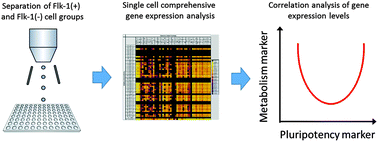Metabolic suppression during mesodermal differentiation of embryonic stem cells identified by single-cell comprehensive gene expression analysis†
Abstract
Flk-1 (VEGF receptor 2) is a well-defined mesodermal progenitor marker and the Flk-1-positive (Flk-1(+)) cells derived from embryonic stem cells (ESCs) have been known to generate hemangioblasts and cardiovascular progenitor cells, which are formed in the early and late stages of differentiation, respectively. In this study, we separated Flk-1(+) and Flk-1(−) cells from spontaneously differentiating embryoid bodies (EBs) of mouse ESCs. We found that cell aggregates derived from late stage Flk-1(+) cells had a relatively small size and a low oxygen consumption rate (OCR) compared with those derived from Flk-1(−) cells. Furthermore, using single-cell comprehensive gene expression analysis, we found that both Flk-1(+) and Flk-1(−) cells could be categorized into subgroups with either low or high glucose metabolic activity. We observed that metabolic suppression occurs in cells expressing an intermediate level of both Nanog and Pou5f1. Taken together, our data suggested that the temporary metabolic suppression is an intrinsic feature of mesodermal differentiation.


 Please wait while we load your content...
Please wait while we load your content...